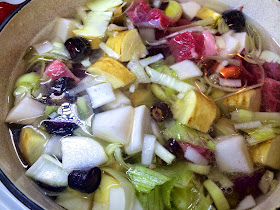 |
The image of Vikings in contemporary culture bears little resemblance to the actual Nordic people who, from the 8th to 11th centuries, exploded onto the global scene. While it’s easy to imagine a horned warrior subsisting on roasted meat and beer, the reality of both the Vikings and their food is a good deal more complex.
Despite the harsh climate of Northern Europe, the Viking diet was fairly robust. It was characterized by a cycle of extreme abundance in the warm months and extreme scarcity in the cold. The Viking imperative, therefore, was to accumulate and preserve as much food as possible in preparation for winter. Smoking, drying, fermenting, were but a few of the ways perishable food was preserved. The Icelandic dish, hákarl, prepared by allowing a shark to ferment underground for weeks is a relic of this style of eating.
Even meat was seasonal as farmers determined how much of their flock could reasonably be kept alive over the winter. Prior to the arrival of Christianity, horse was consumed with some regularity, but was banned by the church because of associations with paganism. Cows were kept in huge numbers, but valued more as a source of dairy than of meat.
The Vikings ate two major meals a day, dagmál and natmál which coincided with the beginning and end of the working day. Food was typically eaten out of a shallow, wooden bowl using a knife and spoon. Feasts were a regular occurrence among the wealthier classes, and served to reaffirm bonds of loyalty between a jarl and his thanes.
Un-hopped ale was consumed daily in place of water. Mead, a drink of fermented honey, and imported foreign wines were typically reserved for celebrations. Viking alcohol consumption is legendary, and feasts would have been no exception. Because feasts were often held as part of diplomatic negotiations, Viking sagas often caution against drinking to excess. It was not uncommon for entire treaties to be renegotiated after the involved parties sobered up.
|
 |
| Next, we slowly form the dough into a round or oval shaped cake. |
 |
| And dust the entire cake with flour. |
 |
| Using a knife to score the top of the cake will allow it to be easily broken apart by hand once it is baked. It isn't necessary to cut deep. |
 |
| Once cooked though, the bread will easily break apart along the lines we cut earlier. This is useful because the majority of dining was done by hand. |
 |
| All of these vegetables are fairly easy to store, making them ideal for the short Viking growing season. |
 |
| We toss some bacon into a pot to draw out the cooking fat. |
 |
| Shortly before serving, add some dill. Because dill will lose its potency with prolonged cooking, allow it only enough time to soften before removing from heat. |
 |
| Here, we gently melt butter in a pan to prepare our sauce. |
 |
| Mustard was widely available and consumed in Scandinavia. Here we slowly fold in mustard powder and cumin, stirring constantly. |
 |
| The mustard sauce is ready when completely smooth. |
 |
| Once our eggs are boiled, they are ready to be peeled and chopped up. |
 |
| Blend together the eggs, sauce, and a handfull of dill. |
 |
| Here the pork is ready to be sliced into bite-sized pieces and covered in sauce. Because of the available utensils, dishes had to be served in such as way as to be readily eaten by hand. |
 |
| Our sauce will consist simply of lingonberries and butter. The environment of Scandinavia provided the Vikings with an abundance of wildly available fruit to supplement their cultivated orchards. |
 |
| Once the butter has melted, we cover with water and allow the sauce to reduce over a very gentle heat. |
 |
| Drop your herring into extremely hot walnut oil. The trade in stockfish was a critical aspect of the Icelandic economy, where stockfish was traded for grain from mainland Scandinavia. |
 |
| Once the fish turns golden, remove it from the oil and allow it to drain. |
 |
| Our final menu: Lamb Skause, barley bread, walnuts, dried plumbs, roasted pork with lingonberry sauce, fried herring, eggs in mustad, and skyr. Wash it all down with a generous amount of ale or mead. |














Hello, and thank you for the great article on viking food!! I was wondering if you had a source you could point me at for the the skause. I am looking to learn more about the practice of keeping the pot cooking over multiple days. Thank you!
ReplyDeletehttps://darley-newman.com/welsh-lobscouse-recipe/
DeleteInteresting, thanks
ReplyDeleteGreat post. Really interesting.
ReplyDelete